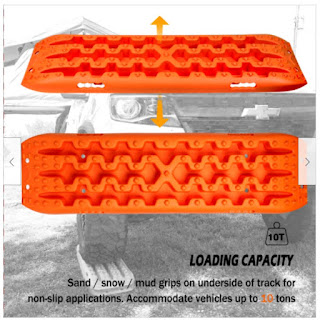I'd recently encountered rocky trail conditions that had looked so bad that I chose to not try them with the VRRV. This of course is the reason I do a recce on Yagi, my TW200, when I don't know if the road conditions are good enough.
This led to me camping somewhere where there were too many neighboring campers, groups of noise OHV swine, and one over-revving imbecile.
Sometimes, avoiding the sketchy terrain sections, doesn't work out great in other ways. So, I figured there might be an option for temporary terrain aids when options are limited.
I initially looked into thick rubber mats to use as "padding" or "build up" bits where trail conditions might be too rough for the VRRV.
I went through the gamut from fancy $60/apiece (if you buy 4) rubber blocks used for ramps and stops in construction areas:
source: Vodaland
To perhaps obtaining, then cutting up, a used large truck tire, into sections similar in dimensions to the above mats.
Then, I remembered something. Back when I had purchased the Sammy, I had bought for it all kinds of recovery gear and such for anticipated off road 4x4 adventures.
One of the items bought was a pair of Recovery Tracks made by X-Bull, and supposed to hold up to 10 tons on flat ground.
So I got them out of storage and first tried rolling the rear tire of Martha's CRV on top. Before I did, I put a couple of wood blocks to create a gap. I wanted to see how the track would bend:
Then it was the VRRV's turn for testing. This time I put the tracks to span the sidewalk bump that leads to my driveway. I supported both sides with a wooden block and it did fine, hardly even bent.
First, the left front tire:
This time I left the left side intentionally unsupported to see if it could take the weight and rolled the VRRV's inner dually tire onto the track. The dually axle supports a weight of 8080 lbs. when the VRRV is fully loaded.
For the brief periods I intend to use these tracks in spanning rough spots, I figure having the outer dually tire "hanging" will be fine.
Here's a short video on how it did with the dually tire rolling onto it. As you might imagine, putting wooden blocks in the gap area will help ensure weight isn't an issue.
So, the recovery tracks are now part of the loadout for the VRRV. The idea is still to try and avoid sketchy terrain conditions if possible, but having the option to "go for it" is nice to have.
I'm thinking having some kind of anchoring stakes to keep the tracks from moving while under load will be a good thing.
Another hazard of taking the VRRV into off road conditions, is that sometimes there's vegetation right on the edge of the trail. Vegetation that could snag the cap of the dump tube and rip it off. I don't really mind losing the cap, but it could also in turn rip up the tube's valve assembly and that would shitty. Literally.
The dump tube and the cap it came to me with,
the extended handle used to provide good turning access.
Note the gray narrow tube closer to you, that's the gray water valve handle. The handle portion disappeared sometime in the last camping trip. It used to also stick out a bit from the underside of the VRRV! Still functional luckily, so missing the handle is no big deal.
Sticks out enough to snag something under very
narrow trail conditions.
In the above picture, you might be thinking that it's not that far out, the dump tube cover. If you look forward of it a bit, you can see the generator's exhaust pipe....also not sticking out so much. I have though, managed to snag that pipe before, resulting it it being bent back! I recall moving over to the left side of the trail, to avoid large ruts on the right side; so I had the VRRV's left flank brushing the bushes!
New cap in place, hopefully less chance of snagging.
I had toyed with the idea of moving the dump tube up more but because of the way the gray water dump tube mates to it, it would have been very difficult if not impossible.
As it is now, it's got 14" of ground clearance and is right behind the left rear tires, so it should be fine that way. Other parts of the VRRV's underside will be scraping long before this does! It will also mean, I failed in my recce of the route and will have to pay the piper.












4 comments:
Since you have the front receiver, you could also carry a winch like Michael aka Conchscooter added to his class B van.
Nice solution to not snagging the drain cap, but what did you find to accomplish that? Same cap but removed the handle? Found a different cap? And how did you attach it?
Love DIY solutions like you and Richard come up with.
Thanks for sharing.
RichardM, front receiver is used by me cargo rack for the TW. Sure, it's removable but it would be a bit of a PITA. I am not that worried about getting the rig stuck, I am trying to avoid the deadly side wobbles such a top heavy vehicle can experience when the tires on an axle encounter terrain that is not the same height on both sides.
CCjon, the new cab is actually made by the same outfit that made the original cap, a simple swap. It secures onto the tube in the same manner.
Post a Comment